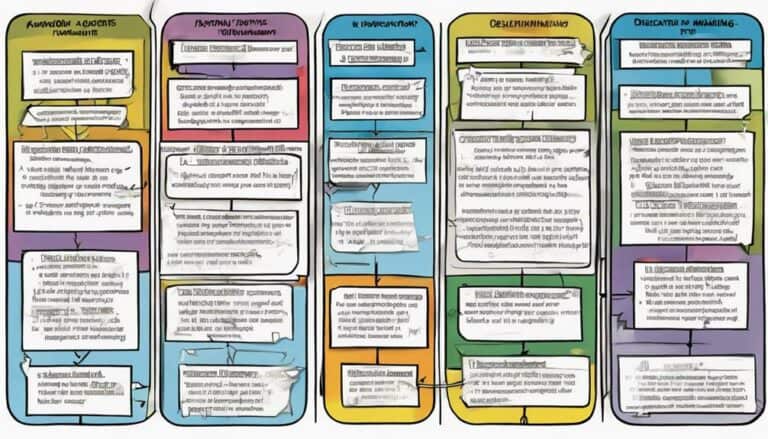When faced with complex decisions, a decision-making framework offers clarity, consistency, and a roadmap for guiding uncertainties.
But how can such a framework truly enhance transparency in your decision-making processes? By unraveling the intricate layers of accountability, honing in on ethical considerations, and fostering a culture of openness, a decision-making framework can pave the way for a more transparent and inclusive decision-making environment.
The key lies in understanding how these frameworks not only streamline choices but also lay the groundwork for trust and collaboration within your organization.
Key Takeaways
- Enhances transparency and consistency in decision-making.
- Provides structured guidelines for open and accountable decisions.
- Aligns decisions with organizational values, fostering trust.
- Clearly outlines roles and responsibilities for improved communication and accountability.
Benefits of Using a Decision-Making Framework
When utilizing a decision-making framework, organizations experience enhanced transparency and consistency in their decision-making processes. Decision-making frameworks provide structured guidelines and criteria that increase transparency by ensuring that decisions are made openly and accountably. By encouraging transparency, these frameworks help organizations align their decisions with their values and goals, fostering trust among stakeholders.
Additionally, decision-making frameworks outline roles and responsibilities clearly, which not only enhances communication but also clarifies accountability, further promoting transparency within the organization. Through the use of a framework, organizations can streamline their decision-making processes, leading to more consistent and fair outcomes.
Moreover, decision-making frameworks promote collaboration among team members, as everyone understands the criteria and process for making decisions. This collaborative approach not only enhances transparency but also builds a culture of shared responsibility and trust within the organization.
Elements of Transparent Decision-Making
Transparent decision-making hinges on openly sharing information with stakeholders, ensuring clarity and accountability throughout the process. When making important decisions, it is vital to take diverse perspectives into account and promote transparency to maintain trust and credibility. By actively involving all affected parties in the decision-making process, you can guarantee that decisions are made with a thorough understanding of the situation. Documenting the decisions and the rationale behind them fosters accountability and transparency, allowing for scrutiny and feedback. Consistently applying decision-making standards and principles reinforces transparency in the decision-making process, building confidence and understanding among stakeholders.
| Elements of Transparent Decision-Making | Description |
|---|---|
| Information Sharing | Openly sharing relevant information with stakeholders is essential for transparency in decision-making processes. |
| Involving Diverse Perspectives | Taking into account a variety of viewpoints helps in making well-informed decisions and promotes transparency. |
| Documenting Decisions | Recording decisions and the reasons behind them fosters accountability and transparency in the decision-making process. |
Implementing Transparency in Decision Processes
To guarantee transparency and accountability in decision processes, a well-defined decision-making framework can serve as a guiding beacon for team members and stakeholders alike. When implementing transparency in decision processes, consider the following:
- Involve Stakeholders: Actively engage stakeholders in the decision-making process to gather diverse perspectives and insights, fostering transparency and inclusivity.
- Document Decisions: Record decisions and the rationale behind them within the framework to create a transparent trail of the decision-making journey for future reference and learning.
- Align with Organizational Values: Make sure that the decision-making framework aligns criteria with the organization's vision and mission, underscoring the logic and purpose behind decision choices.
Role of Stakeholders in Transparent Decision-Making
Stakeholders' active involvement in decision-making processes is fundamental to fostering transparency, accountability, and inclusivity within an organization. When stakeholders are engaged in the decision-making framework, they bring diverse perspectives and insights that enrich the decision process.
This involvement not only enhances transparency but also promotes buy-in and ownership of decisions. Stakeholders play an important role in providing valuable feedback and information that can shape the direction of decisions. Transparency in decision-making guarantees that stakeholders understand the reasoning behind decisions, leading to a sense of respect and inclusion.
Strategies for Enhancing Decision-Making Transparency
Establishing clear guidelines and criteria is essential for enhancing transparency in decision-making processes within organizations. To improve transparency in decision-making, make sure to involve others in the process. This not only increases transparency but also considers diverse perspectives and empowers team members.
Additionally, communicate openly by sharing relevant information and addressing concerns. Fostering a culture of honest communication within the team is key to enhancing transparency.
Learning from mistakes is vital. Acknowledge errors, encourage feedback for improvement, and use past mistakes to enhance future decision-making processes.
Conclusion
To sum up, implementing a decision-making framework can greatly enhance transparency in your organization's decision-making processes.
Did you know that 86% of employees believe transparency in decision-making is essential for building trust within a team?
By following the outlined elements and involving stakeholders, you can guarantee that decisions are made openly, ethically, and with the input of all relevant parties.
Transparency is key to fostering collaboration and trust within your organization.

